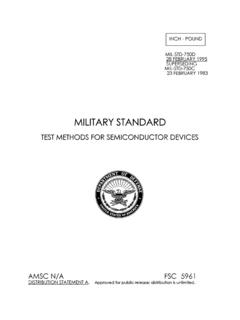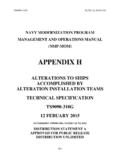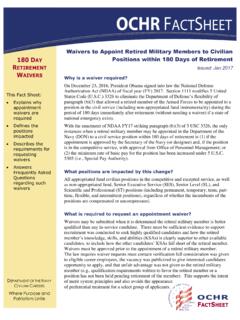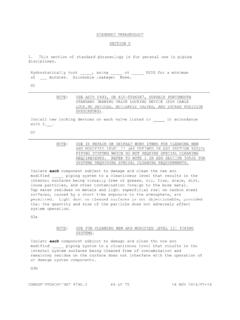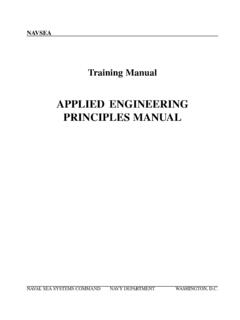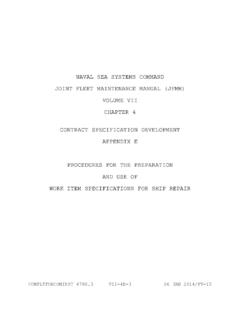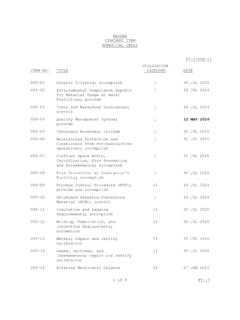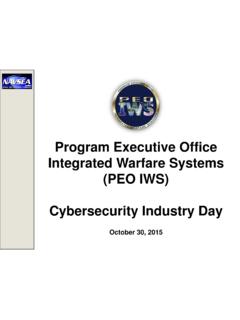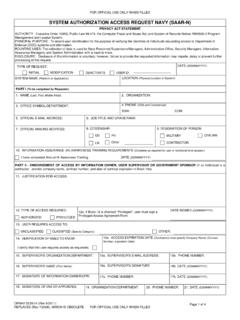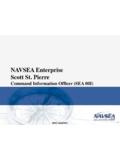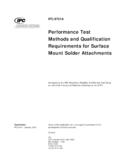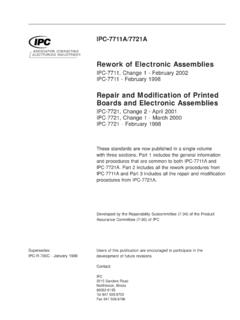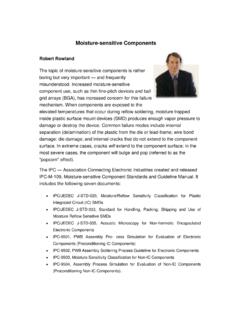Transcription of JESD22-A112-A Page 1
1 jesd22 - a112 -APage 1 Test Method a112 -AJESD22- a112 -APage 2 Test Method a112 -ATEST METHOD a112 -AMOISTURE-INDUCED STRESS SENSITIVITY FOR PLASTIC SURFACE MOUNT DEVICES(From JEDEC Council Ballot JCB-95-37,Formulated Under the Cognizance of ,Committee on Reliability Test Methods for Packaged Devices)1. PURPOSEThe purpose of this test method is to identify the potentialclassification level of plastic Surface Mount Devices (SMDs) that aresensitive to moisture-induced stress so that they can be properlypackaged, stored, and handled to avoid subsequent mechanical damage duringthe assembly solder reflow attachment and/or repair test method may be used to determine what classification level shouldbe used for initial reliability initial qualification exists and no major changes have been made, thismethod may be used for reclassification to an improved level (longer floorlife up to level 2).
2 The reclassification level cannot be improved bymore than one level without additional reliability components classified as moisture sensitive by any previous version ofA112 may be reclassified as nonmoisture sensitive (Level 1) withoutadditional reliability stress testing ( , jesd22 A113 and JESD47 orthe semiconductor manufacturer's in-house procedures).Passing the reject criteria in this test method is not sufficient byitself to provide assurance of long term INTENTM oisture inside a plastic package turns to steam and expands rapidly whenthe package is exposed to the high temperature of VPR (vapor phasereflow), IR (infrared) soldering, or, if the package is submerged inmolten solder, wave soldering. Under certain conditions, the pressurefrom this expanding moisture can cause internal delamination of theplastic from the chip and/or leadframe, internal cracks that do not extendto the outside of the package, bond damage, wire necking, bond lifting,thin film cracking, or cratering beneath the bonds.
3 In the most severecase, the stress can result in external package cracks. This is commonlyreferred to as the "popcorn" phenomenon because the internal stress causesthe package to bulge and then crack with an audible "pop". SMDs are moresusceptible to this problem than through-hole parts because they areexposed to higher temperatures during reflow soldering. The reason forthis is that the soldering operation must occur on the same side of theboard as the SMD device. For through-hole devices, the soldering operationoccurs under the board, which shields the devices from the hot , SMDs have a smaller minimum plastic thickness from the chip or mountJESD22- a112 -APage 3 Test Method a112 -Apad interface to the outside package surface, which has been identifiedas a critical factor in determining moisture APPARATUSThis test method requires as a minimum access to the following equipmentplus the capability for performing "polished" cross section analysis (notrequired if optional Scanning Acoustic Microscopy is used).
4 Moisture chamber(s), capable of operating at 85 C/85% RH, 85 C/60%RH, and 30 C/60% RH. Within the chamber working area, temperaturetolerance must be 2 C and the RH tolerance must be 3% Solder Reflow Infrared (IR)/Convection solder reflow equipment capable ofmaintaining the reflow profile outlined in VPR chamber capable of operating from 215-219(C. The chambermust be capable of heating the packages without collapsing thevapor blanket and recondensing the vapor to minimize loss ofthe vapor phase soldering liquid. The vapor phase solderingfluid must vaporize at +215 +4/0( : The moisture sensitivity classification test resultsare dependent upon the package body temperature (rather thanboard or lead temperature) and VPR is known to be morecontrollable and repeatable than IR/Convection.))
5 As a result,when there are correlation problems between VPR and IR/Convection, the VPR results shall be considered as Bake oven capable of operating at 125 +5/0 Optical Microscope (40X for external and 100X for cross-sectionexam). DC electrical test equipment capable of performing room temperaturedc and functional Optional weighing apparatus capable of weighing the package withaccuracy of ( to a resolution of ( This apparatus mustbe maintained in a draft-free environment, such as a cabinet. Itwould be used to obtain absorption and desorption data on the devicesunder test (see Paragraph 7). Optional Scanning Acoustic to IPC-TM-650, Test Methods Manual, Number , foroperation of the Scanning Acoustic 4 Test Method a112 -ANOTE: The Scanning Acoustic Microscope is a useful tool for helpingdetermine the level of moisture sensitivity classification ofpackages.))
6 However, there is no "one-to-one" correlation betweendelamination and future electronic component failure or have been component failures traced to delamination at varioussites. Some of these failures have been caused by faulty techniquesused to remove components from the printed wiring TEST There are six (6) moisture sensitivity levels as outlined in tableI. Components classified by the manufacturer to the previousrevision of this document need not be reclassified using the criteriaof this revision provided the specified floor life out of the bagdoes not change from the previous classification. If it is desiredto upgrade the product by extending the floor life out of the bag,then the product must be reclassified in accordance with the criteriaof this document.
7 The recommended procedure is to start testing atthe lowest moisture sensitivity level the evaluation package isreasonably expected to pass (based on knowledge of other similarevaluation packages). Samples may be run concurrently on one or moremoisture sensitivity levels. Testing must be continued until apassing level is found. For each evaluation package consisting ofan SMD package type (SOIC-small outline IC, PQFP-plastic quad flatpack, PLCC-plastic leaded chip carrier, etc.), number of pins, moldcompound, and die pad area to be evaluated, select a sample of 10units for each moisture sensitivity level to be tested. A minimumof two nonconsecutive assembly lots must be included in the samplewith each date code having approximately the same units shall have completed all manufacturing processingrequired prior to In order to minimize testing, the results from a given SMD packagetype, mold compound, and die pad area may be accepted to cover allother devices in the same SMD package, same mold compound, and sameor smaller die pad Perform a room temperature electrical dc and functional test toverify that the devices meet the room temperature data sheetspecification.
8 Replace any devices that fail to meet Perform an initial external visual and acoustic microscopeexamination to establish a baseline for delamination criteria Bake the sample for 24 hours minimum at 125 +5/0 C. This step isintended to remove all moisture from the package so that it will be"dry."NOTE: This time may be modified if desorption data on the particularJESD22- a112 -APage 5 Test Method a112 -Adevice under test shows that more or less time is required to obtaina "dry" package when starting in the wet condition for 85 C/85% Each sample of ten (10) units shall at all times be handled withadequate precautions to ensure that ESD damage does not occur. Placedevices in a clean, dry, shallow container so that the parts do nottouch each other.
9 Submit each sample to the appropriate soakrequirements shown in table Remove the devices from the temperature/humidity chamber and allowthem to dry for a minimum of fifteen (15) Not sooner than fifteen (15) minutes and not longer than four (4)hours after removal from the temperature/humidity chamber, submitthe sample to either three (3) cycles of VPR at 215-219 C for 60seconds or three (3) cycles of IR/Convection that meet the rate+6 C/second maxTemperature maintained at 125( 25) C120 seconds maxTemperature maintained above 180 C120-180 secondsTime at maximum temperature10-40 secondsMaximum temperature220+5/0 CRamp-down rate-6 C/second maxAll temperatures refer to top side of the package, measured on thepackage body surface. The devices shall be allowed to cool down forfive (5) minutes minimum between VPR or IR/Convection Examine the devices from each sample under a microscope (40X) tolook for external Perform electrical room temperature dc and functional tests on A device is considered a failure if it exhibits any of the following.
10 (a) external crack visible under 40X optical microscope(b) electrical room temperature dc or functional failure(c) internal crack that intersects a bond wire, ball bond, or wedgebond(d) internal crack extending from any lead finger to any otherinternal feature (lead finger, chip, die attach paddle)(e) internal crack extending more than two-thirds (2/3) the distancefrom any internal feature to the outside of the If internal cracks are suspected based on acoustic microscopy,polished cross sections should be made to verify the suspectedJESD22- a112 -APage 6 Test Method a112 -Asite(s). In lieu of evidence of suspected crack sites, section halfthe devices from each sample with a vertical section through themiddle of the package (when viewed from either side or end).
